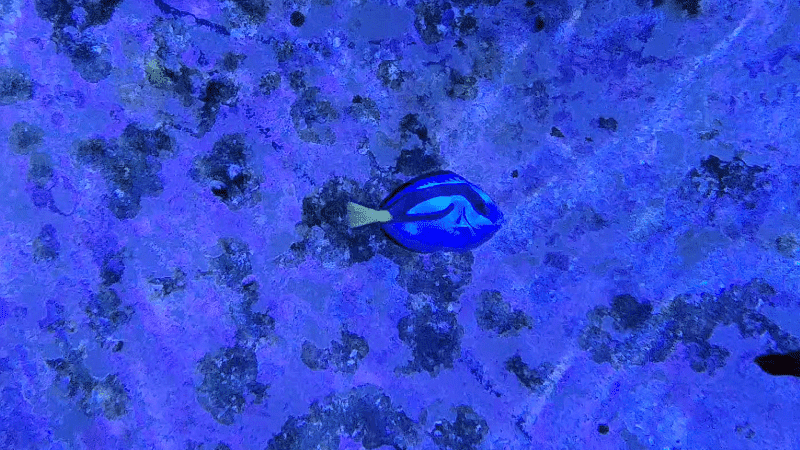The Blue Tang, popularly known as Dory from the animated film “Finding Nemo,” is a stunning and mesmerizing aquarium fish that has captured the hearts of fish enthusiasts worldwide. With its striking blue color and graceful swimming style, keeping a Blue Tang in your home aquarium can add a touch of the ocean’s beauty to your living space. However, caring for this species requires some specific attention and consideration to ensure their well-being. In this blog, we will guide you through the essential aspects of caring for a Blue Tang, helping you create a thriving environment for your beloved “Finding Nemo” fish.
Providing the Right Tank Environment
Creating a suitable and thriving environment for your Blue Tang is crucial to their health and happiness. Consider the following factors:
Tank Size: Blue Tangs are active swimmers and can grow up to 12 inches (30 cm) in length. As such, they require a spacious tank to thrive. Aim for a minimum tank size of 180 gallons (680 liters) to accommodate their swimming habits and provide ample space for their social behavior.
Water Parameters: Maintaining optimal water parameters is crucial for the health of your Blue Tang. The recommended temperature range is between 75°F to 82°F (24°C to 28°C), with a pH level between 8.1 and 8.4. Additionally, keep the specific gravity of the water between 1.020 to 1.025. Regularly test the water and perform water changes as needed to maintain stable conditions.
Filtration and Water Flow: A robust filtration system is essential to keep the water clean and free from pollutants. Additionally, Blue Tangs are accustomed to strong water currents in their natural habitat, so providing moderate to high water flow in the tank will mimic their natural environment and promote their well-being.
Substrate and Decor: Opt for a sandy substrate to mimic the ocean floor, where Blue Tangs can forage for food naturally. Live rocks and coral structures will not only add beauty to the tank but also offer hiding spots for the fish, reducing stress and providing a sense of security.
Diet and Feeding
A well-balanced diet is crucial to your Blue Tang’s health and vitality. Consider the following feeding recommendations:
Herbivorous Diet: Blue Tangs are herbivores, meaning their diet consists mainly of algae and marine vegetation. Providing a well-balanced herbivorous diet is crucial to their health and vitality.
Algae Sheets: Offer high-quality algae sheets specifically formulated for herbivorous fish. Blue Tangs will graze on these sheets throughout the day, mimicking their natural feeding habits.
Frozen Foods: Supplement their diet with frozen foods such as brine shrimp, mysis shrimp, and spirulina-enriched preparations. These will provide essential nutrients and variety to their diet.
Fresh Vegetables: Occasionally offer blanched spinach, kale, or Nori seaweed as a treat. Fresh vegetables will provide additional nutrients and enrichment for your Blue Tang.
Avoid Overfeeding: Blue Tangs are susceptible to overeating, which can lead to health issues. Feed them small, frequent meals throughout the day, and observe their intake to prevent overfeeding.
Tank Mates and Behavior
Selecting compatible tank mates and understanding their behavior will contribute to your Blue Tang’s overall well-being. Consider the following:
Peaceful Tank Mates: While Blue Tangs are generally peaceful, it’s essential to choose tank mates carefully. Avoid aggressive or territorial species that may intimidate or harm the Blue Tang. Compatible tank mates include other herbivorous fish, peaceful surgeonfish, and some wrasses.
Schooling Behavior: Blue Tangs are known for their schooling behavior in the wild. If you plan to keep more than one Blue Tang, ensure the tank is large enough to accommodate their social interactions and prevent territorial disputes.
Handling and Acclimation: Blue Tangs can be sensitive to changes in water conditions. When introducing them to your aquarium, use a proper acclimation process to help them adjust gradually to their new environment.
Health and Maintenance
Regular compliance and proactive care are essential for your Blue Tang’s health. Consider the following tips:
Regular Observation: Watch your Blue Tang daily to monitor its behavior and appearance. Examine any signs of stress, disease, or abnormal behavior.
Quarantine New Fish: Quarantine any new fish before adding them to the main tank to prevent introducing potential diseases to your Blue Tang and other tank inhabitants.
Water Quality: Maintain excellent water quality by conducting regular water tests and performing necessary water changes. Stable water parameters are essential for your Blue Tang’s well-being.
Disease Prevention: Keep the tank clean and ensure a proper diet to prevent stress and boost your fish’s immune system. A healthy fish is less susceptible to diseases.
Wrapping It Up
Caring for a Blue Tang in your aquarium requires careful attention and dedication, but the rewards are worth the effort. Providing the right tank environment, a balanced diet, and compatible tank mates will contribute to your Blue Tang’s happiness and longevity. Regular observation and proactive care will help ensure your beloved “Finding Nemo” fish thrives in its aquatic paradise, bringing joy and beauty to your home aquarium for years to come.

